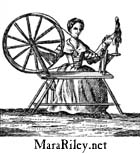| "I made (Garment X) from a pattern and it doesn't fit me." | |
|
Granted, there are some patterns that just don't work. But, by
and large, many of them are just fine. I am quite sick of hearing
people complain about patterns that I think are very good (the J.P.
Ryan Jackets pattern comes to mind) when they haven't taken the basic
steps to make sure the finished garment will fit.
First, did you bother to make a muslin? "What's a muslin?" you ask. Well, a muslin is a version of the garment made up in -- guess what -- muslin. Before you make any garment that needs to fit well, whether modern or 18th century, you should make a muslin. Professional tailors and seamstresses do this all the time. You can then see where the garment needs adjustment and add or subtract fabric accordingly. There are a number of good books on sewing that will tell you how to "read the wrinkles" on a pattern or muslin so you can figure out how to adjust the pattern to fit your particular figure anomalies. I have long arms and a long torso, and a slight sway-back, so I know I generally need to slash a pattern and add about an inch to the torso and arms, and then take in the small of the back just a smidge. Think about it. Unless you are a Perfect Size 10 (or 2, or 20), a pattern will need adjusting to fit you. We're used to buying off-the-rack clothing that doesn't fit very snugly, or which is knitted and therefore stretches to fit without adjustment. But a good 18th century jacket or gown fits much more tightly than modern clothing does, so if you have sloped shoulders or a short waist, the pattern WILL need adjusting for your figure. It's NOT the patternmaker's fault that the pattern wasn't made just for you. Now if you are an experienced sewer and the pattern still gives you fits, that's another story... Go here for reviews of period patterns. Another thing you need to know: clothing sizes vary widely, and there has been a considerable amount of size inflation in recent years in off-the-rack clothes, so that a size 10 in women's ready-to-wear clothing is a totally different size from a size 10 in clothing patterns. Measure yourself carefully before ordering a clothing pattern, and don't be surprised or shocked at the difference in size. It's not your fault; clothing manufacturers have been increasing sizes to flatter their customers, while pattern manufacturers haven't been moving as quickly in that direction. |
|
|
|
|
|
|
|
